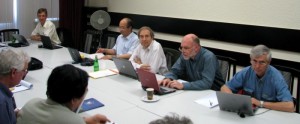
A historical picture: the International Detector Advisory Group IDAG at its first meeting in Warsaw in 2008. Image: Perrine Royole-Degieux.
The Letter-of-Intent (LOI) period of the physics and detector activity of the ILC is coming close to completion. The achievements of the R&D studies during the period have been summarised in the detailed baseline design report (DBD), which will soon be submitted to ILCSC as part of the ILC’s Technical Design Report. It is being polished after the review by the Programme Advisory Committee (PAC) of last December and will be published together with the other TDR volumes. Then our mandate will also be completed.
This period started with the call for Letters of Intent of ILCSC in 2007 – as you can read in my very first RD Report in 2007. It aimed to produce two realistic detector designs which would enable us to pursue the physics at the ILC and to facilitate the settling of the machine-detector interface matters. In summer 2009, two detector groups, ILD and SiD, were validated. These groups consolidated the worldwide efforts of various advanced detector studies and software developments, and integrated them along their concepts in harmonised detector designs. While they had different guidelines for optimisation, each group reached the expected goal of the physics potential. They verified the feasibility of the components and demonstrated the detector performance with realistic simulations of benchmarks. The details of all these R&D studies are presented in the report. The physics volume investigates the physics possibilities of ILC project as a whole, and the detector volume illustrates the capability of the detectors in pursuing them. See the previous RD Report for more details.
The management team for the LOI process oriented the global efforts to this goal. It also facilitated necessary communications among the related groups. However, it did not provide any resources to conduct R&D activities. All the participating groups which submitted the LOIs had to secure their resources for R&D by themselves. The final report is a result of tremendous efforts not only for scientific programmes but also for the resources. The management relied fully on the willingness of the participating groups and individuals for all these efforts. While each of them was also for the future of the community, it was not trivial to keep the activity going for many years and through difficult moments. The management team is really grateful to all of the participating members for their persistent efforts.
We were helped much by the International Detector Advisory Group (IDAG) chaired by Michel Davier through the entire period with their valuable advice. IDAG provided rigorous evaluation for the validation of the LOIs, and after the validation IDAG kept monitoring the whole physics and detector activities towards the goal. Also on the DBD we received much detailed and productive advice from its planning stage, through drafting until its final form. The IDAG members were experienced physicists mostly from outside of the ILC community and busy with their own works. We often handed vast amounts of material to be evaluated in a short period. We heartily appreciated the given advice on them, which addressed all kinds of key points under such tight schedules.
Of course the close communication and cooperation with the accelerator people, in particular with the Global Design Effort (GDE), was indispensable for us to fulfill our mandate. In particular, all the infrastructures prepared by GDE, like the ILC website and the meeting tool, could be used by us, too, and this enabled us to communicate smoothly and to keep records with the assistance of the expert, Maura Barone. I wish to thank Barry Barish for this generous arrangement. Besides the standing communication channel for the Machine Detector Interface issues, there were intense discussions e.g. on the accelerator parameters of the straw man baseline 2009 (SB2009). All of these went fine after all. But often our inertia was large to react quickly due to the size and the diversity of the community. We were assisted by the patience of the accelerator people in such cases.
Since it is the last time for me to write in ILC Newsline, I wish to thank my close colleagues in the physics and detector management. The help and cooperation of the Regional Contacts, Jim Brau of America, Francois Richard and later Juan Fuster of Europe and Hitoshi Yamamoto of Asia, were essentially crucial for me to carry out the given task. Actually I could not have even started without them. The members of the Physics and Experiment Board made many decisions and all the members of the common task groups and other working groups did a lot of practical works, and their contributions all together indeed pushed the activity forward to this point, which I appreciate very much.
At the very end but not the least, the support of the communicators, which was professional and filled the gap we made in various occasions, has always been acknowledged.
The final report marks a clear milestone to show that the community has passed the basic design phase, and is ready to go forward to the next phase of advanced design, which envisages construction and include more engineering studies. Soon the next organisation will start to bring the project ahead. The present management team will stay for a while to make a smooth transition. I wish the new organisation steady progress towards the realisation of the ILC and promote the physics and detector activities as the community envisages.


Recent Comments